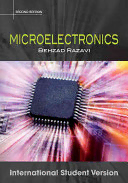Table Of ContentSECOND EDITION
Microelectronics
Behzad razavi
International Student Version
Input and Output Impedances
rO
VA=
r π ac ac ac ac
1
gm
(1 +gmrO((RE r π(+rO
VA= RB VA=
r π+(β+1(RE RE ac RE
ac
1 RB
+
ac ac gm β+1
rO (1 +gmrO(RS+rO
λ= 0
ac ac ac ac 1 ac RS
gm
ac
Microelectronics
Second Edition
Behzad Razavi
University of California, Los Angeles
International Student Version
Copyright(cid:2)c 2015JohnWiley&Sons(Asia)PteLtd
Coverimage(cid:2)c Lepas/Shutterstock
ContributingSubjectMatterExperts:Dr.AnilVNandi,BVBCETHubli;Dr.Ramesha
C.K.,BITSPilani-K.K.BirlaGoaCampus;andDr.LaxminidhiT.,NITKarnataka
Surathkal
Foundedin1807,JohnWiley&Sons,Inc.hasbeenavaluedsourceofknowledgeand
understandingformorethan200years,helpingpeoplearoundtheworldmeettheir
needsandfulfilltheiraspirations.Ourcompanyisbuiltonafoundationofprinciplesthat
includeresponsibilitytothecommunitiesweserveandwhereweliveandwork.In2008,
welaunchedaCorporateCitizenshipInitiative,aglobalefforttoaddressthe
environmental,social,economic,andethicalchallengeswefaceinourbusiness.Among
theissuesweareaddressingarecarbonimpact,paperspecificationsandprocurement,
ethicalconductwithinourbusinessandamongourvendors,andcommunityand
charitablesupport.Formoreinformation,pleasevisitourwebsite:
www.wiley.com/go/citizenship.
Allrightsreserved.ThisbookisauthorizedforsaleinEurope,Asia,Africaandthe
MiddleEastonlyandmaynotbeexported.Thecontentismateriallydifferentthan
productsforothermarketsincludingtheauthorizedU.S.counterpartofthistitle.
ExportationofthisbooktoanotherregionwithoutthePublisher’sauthorizationmaybe
illegalandaviolationofthePublisher’srights.ThePublishermaytakelegalactionto
enforceitsrights.
Nopartofthispublicationmaybereproduced,storedinaretrievalsystem,or
transmittedinanyformorbyanymeans,electronic,mechanical,photocopying,
recording,scanning,orotherwise,exceptaspermittedunderSection107or108ofthe
1976UnitedStatesCopyrightAct,withouteitherthepriorwrittenpermissionofthe
Publisherorauthorizationthroughpaymentoftheappropriateper-copyfeetothe
CopyrightClearanceCenter,Inc.,222RosewoodDrive,Danvers,MA01923,website
www.copyright.com.RequeststothePublisherforpermissionshouldbeaddressedtothe
PermissionsDepartment,JohnWiley&Sons,Inc.,111RiverStreet,Hoboken,NJ07030,
(201)748-6011,fax(201)748-6008,websitehttp://www.wiley.com/go/permissions.
ISBN:978-1-118-16506-5
PrintedinAsia
10 9 8 7 6 5 4 3 2 1
To Angelina and Jahan,
for their love and patience
About the Author
BehzadRazavireceivedtheBSEEdegreefromSharifUniversityofTechnologyin1985
andtheMSEEandPhDEEdegreesfromStanfordUniversityin1988and1992,respec-
tively.HewaswithAT&TBellLaboratoriesandHewlett-PackardLaboratoriesuntil1996.
Since1996,hehasbeenAssociateProfessorandsubsequentlyProfessorofelectricalen-
gineeringatUniversityofCalifornia,LosAngeles.Hiscurrentresearchincludeswireless
transceivers,frequencysynthesizers,phase-lockingandclockrecoveryforhigh-speeddata
communications,anddataconverters.
ProfessorRazaviwasanAdjunctProfessoratPrincetonUniversityfrom1992to1994,
andatStanfordUniversityin1995.HeservedontheTechnicalProgramCommitteesof
the International Solid-State Circuits Conference (ISSCC) from 1993 to 2002 and VLSI
CircuitsSymposiumfrom1998to2002.HehasalsoservedasGuestEditorandAssociate
Editor of the IEEE Journal of Solid-State Circuits, IEEE Transactions on Circuits and
Systems,andInternationalJournalofHighSpeedElectronics.
ProfessorRazavireceivedtheBeatriceWinnerAwardforEditorialExcellenceatthe
1994ISSCC,thebestpaperawardatthe1994EuropeanSolid-StateCircuitsConference,
thebestpanelawardatthe1995and1997ISSCC,theTRWInnovativeTeachingAwardin
1997,thebestpaperawardattheIEEECustomIntegratedCircuitsConferencein1998,
andtheMcGraw-HillFirstEditionoftheYearAwardin2001.Hewastheco-recipientof
both the Jack Kilby Outstanding Student Paper Award and the Beatrice Winner Award
forEditorialExcellenceatthe2001ISSCC.HereceivedtheLockheedMartinExcellence
inTeachingAwardin2006,theUCLAFacultySenateTeachingAwardin2007,andthe
CICC Best Invited Paper Award in 2009 and 2012. He was the co-recipient of the 2012
VLSICircuitsSymposiumBestStudentPaperAward.Hewasalsorecognizedasoneof
thetop10authorsinthe50-yearhistoryofISSCC.ProfessorRazavireceivedtheIEEE
DonaldPedersonAwardinSolid-StateCircuitsin2011.
ProfessorRazaviisaFellowofIEEE,hasservedasanIEEEDistinguishedLecturer,
and is the author of Principles of Data Conversion System Design, RF Microelectron-
ics (translated to Chinese, Japanese, and Korean), Design of Analog CMOS Integrated
Circuits (translated to Chinese, Japanese, and Korean), Design of Integrated Circuits for
OpticalCommunications,andFundamentalsofMicroelectronics(translatedtoKoreanand
Portuguese).HeisalsotheeditorofMonolithicPhase-LockedLoopsandClockRecovery
CircuitsandPhase-LockinginHigh-PerformanceSystems.
iv
Preface
The first edition of this book was published in 2008 and has been adopted by numerous
universitiesaroundtheglobeforundergraduatemicroelectronicseducation.Followingis
adetaileddescriptionofeachchapterwithmyteachingandlearningrecommendations.
Coverage of Chapters The material in each chapter can be decomposed into three
categories:(1)essentialconceptsthattheinstructorshouldcoverinthelecture,(2)essential
skillsthatthestudentsmustdevelopbutcannotbecoveredinthelectureduetothelimited
time, and (3) topics that prove useful but may be skipped according to the instructor’s
preference.1Summarizedbelowareoverviewsofthechaptersshowingwhichtopicsshould
becoveredintheclassroom.
Chapter1: IntroductiontoMicroelectronics Theobjectiveofthischapteristopro-
videthe“bigpicture”andmakethestudentscomfortablewithanaloganddigitalsignals.
Ispendabout30to45minutesonSections1.1and1.2,leavingtheremainderofthechapter
(Basic Concepts) for the teaching assistants to cover in a special evening session in the
firstweek.
Chapter2: BasicSemiconductorPhysics Providingthebasicsofsemiconductorde-
vicephysics,thischapterdeliberatelyproceedsataslowpace,examiningconceptsfrom
differentanglesandallowingthestudentstodigestthematerialastheyreadon.Aterse
language would shorten the chapter but require that the students reread the material
multipletimesintheirattempttodeciphertheprose.
Itisimportanttonote,however,thattheinstructor’spaceintheclassroomneednot
be as slow as that of the chapter. The students are expected to read the details and the
examplesontheirownsoastostrengthentheirgraspofthematerial.Theprincipalpoint
inthischapteristhatwemuststudythephysicsofdevicessoastoconstructcircuitmodels
for them. In a quarter system, I cover the following concepts in the lecture: electrons
andholes;doping;driftanddiffusion; pnjunctioninequilibriumandunderforwardand
reversebias.
Chapter3: DiodeModelsandCircuits Thischapterservesfourpurposes:(1)makethe
studentscomfortablewiththe pnjunctionasanonlineardevice;(2)introducetheconcept
oflinearizinganonlinearmodeltosimplifytheanalysis;(3)coverbasiccircuitswithwhich
any electrical engineer must be familiar, e.g., rectifiers and limiters; and (4) develop the
skills necessary to analyze heavily-nonlinear circuits, e.g., where it is difficult to predict
which diode turns on at what input voltage. Of these, the first three are essential and
shouldbecoveredinthelecture,whereasthelastdependsontheinstructor’spreference.
(Icoveritinmylectures.)Intheinterestoftime,Iskipanumberofsectionsinaquarter
system,e.g.,voltagedoublersandlevelshifters.
Chapter 4: Physics of Bipolar Transistors Beginning with the use of a voltage-
controlled current source in an amplifier, this chapter introduces the bipolar transistor
1Suchtopicsareidentifiedinthebookbyafootnote.
v
vi Preface
asanextensionof pnjunctionsandderivesitssmall-signalmodel.AswithChapter2,the
pace is relatively slow, but the lectures need not be. I cover structure and operation of
the bipolar transistor, a very simplified derivation of the exponential characteristic, and
transistormodels,mentioningonlybrieflythatsaturationisundesirable.SincetheT-model
oflimiteduseinanalysisandcarrieslittleintuition(especiallyforMOSdevices),Ihave
excludeditinthisbook.
Chapter 5: Bipolar Amplifiers This is the longest chapter in the book, building the
foundation necessary for all subsequent work in electronics. Following a bottom-up
approach,thischapterestablishescriticalconceptssuchasinputandoutputimpedances,
biasing,andsmall-signalanalysis.
While writing the book, I contemplated decomposing Chapter 5 into two chapters,
one on the above concepts and another on bipolar amplifier topologies, so that the lat-
ter could be skipped by instructors who prefer to continue with MOS circuits instead.
However,teachingthegeneralconceptsdoesrequiretheuseoftransistors,makingsuch
adecompositiondifficult.
Chapter 5 proceeds slowly, reinforcing, step-by-step, the concept of synthesis and
exploringcircuittopologieswiththeaidof“Whatif?”examples.AswithChapters2and
4,theinstructorcanmoveatafasterpaceandleavemuchofthetextforthestudentsto
readontheirown.Inaquartersystem,Icoverallofthechapter,frequentlyemphasizing
the concepts illustrated in Figure 5.7 (the impedance seen looking into the base, emit-
ter, or collector). With about two (perhaps two and half) weeks allotted to this chapter,
thelecturesmustbepreciselydesignedtoensurethemainconceptsareimpartedinthe
classroom.
Chapter6: PhysicsofMOSDevices ThischapterparallelsChapter4,introducingthe
MOSFET as a voltage-controlled current source and deriving its characteristics. Given
the limited time that we generally face in covering topics, I have included only a brief
discussionofthebodyeffectandvelocitysaturationandneglectedthesephenomenafor
theremainderofthebook.Icoverallofthischapterinourfirstcourse.
Chapter7: CMOSAmplifiers Drawingextensivelyuponthefoundationestablishedin
Chapter5,thischapterdealswithMOSamplifiersbutatafasterpace.Icoverallofthis
chapterinourfirstcourse.
Chapter 8: Operational Amplifier as a Black Box Dealing with op-amp-based cir-
cuits,thischapteriswrittensuchthatitcanbetaughtinalmostanyorderwithrespectto
otherchapters.Myownpreferenceistocoverthischapterafteramplifiertopologieshave
beenstudied,sothatthestudentshavesomebareunderstandingoftheinternalcircuitryof
opampsanditsgainlimitations.Teachingthischapterneartheendofthefirstcoursealso
placesopampsclosertodifferentialamplifiers(Chapter10),thusallowingthestudentsto
appreciatetherelevanceofeach.Icoverallofthischapterinourfirstcourse.
Chapter 9: Cascodes and Current Mirrors Thischapterservesasanimportantstep
toward integrated circuit design. The study of cascodes and current mirrors here also
provides the necessary background for constructing differential pairs with active loads
or cascodes in Chapter 10. From this chapter on, bipolar and MOS circuits are covered
togetherandvarioussimilaritiesandcontrastsbetweenthemarepointedout.Inoursecond
microelectronics course, I cover all of the topics in this chapter in approximately two
weeks.
Preface vii
Chapter 10: Differential Amplifiers This chapter deals with large-signal and small-
signalbehaviorofdifferentialamplifiers.Thestudentsmaywonderwhywedidnotstudy
the large-signal behavior of various amplifiers in Chapters 5 and 7; so I explain that the
differentialpairisaversatilecircuitandisutilizedinbothregimes.Icoverallofthischapter
inoursecondcourse.
Chapter 11: Frequency Response Beginning with a review of basic concepts such
asBode’srules,thischapterintroducesthehigh-frequencymodeloftransistorsandana-
lyzesthefrequencyresponseofbasicamplifiers.Icoverallofthischapterinoursecond
course.
Chapter 12: Feedback and Stability Most instructors agree the students find feed-
back to be the most difficult topic in undergraduate microelectronics. For this reason,
I have made great effort to create a step-by-step procedure for analyzing feedback cir-
cuits,especiallywhereinputandoutputloadingeffectsmustbetakenintoaccount.Aswith
Chapters2and5,thischapterproceedsatadeliberatelyslowpace,allowingthestudentsto
becomecomfortablewitheachconceptandappreciatethepointstaughtbyeachexample.
Icoverallofthischapterinoursecondcourse.
Chapter13: Oscillators Thisnewchapterdealswithbothdiscreteandintegratedoscil-
lators.Thesecircuitsarebothimportantinreal-lifeapplicationsandhelpfulinenhancing
the feedback concepts taught previously. This chapter can be comfortably covered in a
semestersystem.
Chapter14: OutputStagesandPowerAmplifiers Thischapterstudiescircuitsthat
deliver higher power levels than those considered in previous chapters. Topologies such
as push-pull stages and their limitations are analyzed. This chapter can be covered in a
semestersystem.
Chapter15: AnalogFilters Thischapterprovidesabasicunderstandingofpassiveand
activefilters,preparingthestudentformoreadvancedtextsonthesubject.Thischapter
canalsobecomfortablycoveredinasemestersystem.
Chapter 16: Digital CMOS Circuits This chapter is written for microelectronics
courses that include an introduction to digital circuits as a preparation for subsequent
coursesonthesubject.Giventhetimeconstraintsinquarterandsemestersystems,Ihave
excludedTTLandECLcircuitshere.
Chapter 17: CMOS Amplifiers This chapter is written for courses that cover CMOS
circuits before bipolar circuits. As explained earlier, this chapter follows MOS device
physicsand,inessence,issimilartoChapter5butdealswithMOScounterparts.
ProblemSets Inadditiontonumerousexamples,eachchapteroffersarelativelylarge
problem set at the end. For each concept covered in the chapter, I begin with simple,
confidence-building problems and gradually raise the level of difficulty. Except for the
devicephysicschapters,allchaptersalsoprovideasetofdesignproblemsthatencourage
studentstowork“inreverse”andselectthebiasand/orcomponentvaluestosatisfycertain
requirements.

